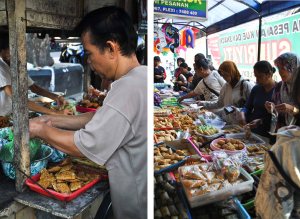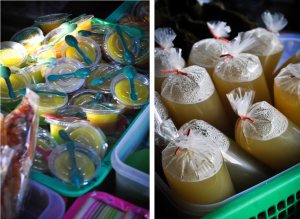The archipelago of Indonesia is the largest archipelago and one of most populous country in the world, with its more than 17 thousand islands and 230 million inhabitants. Indonesia stretches along the equator, whereas beaches, mountains, rivers, tropical forest, mega-politan cities, villages are enriching the beauty of the country.
Its vary ethnics background influences the cuisine culture of Indonesia for sure. One of the most popular dishes of the country is SATE or SATAY. Diced or sliced seasoned meat that is grilled in a skewer, made from bamboo, coconut palm frond or metal. The barbecued meat then is served with sauce from various spices and seasoning mixture.
US President Obama, who spent his childhood in Jakarta the capital of Indonesia, has mentioned SATAY as one of his memorable food, when he visited Indonesia in 2010. Each region in Indonesia will have their own characteristic for their SATAY, and here we shall start the journey!
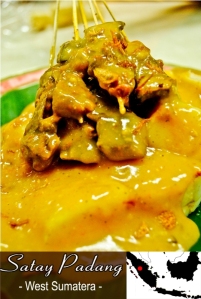
SATAY PADANG (West Sumatera)
What is prominent from this beef satay is its thick spicy sauce. The sauce is a mixture between turmeric, ginger, garlic, coriander, galangal and cumin. To blend all of these spices then rice flour and water is added. There are actually three types of SATAY PADANG, from three different regions in West Sumatera. They are differentiated by the color of the sauce: yellow, red, orange. The ingredient of the sauce and its taste of course are different.

SATAY AMBAL (Central Java)
It is name of a District in Central Java. Once again, it is about the sauce. It has been from generation to generation that people in Ambal District has used tempeh (fermented soya cake) as the base for the sauce. Tempeh is grounded together with chili, shallot and garlic. It is uncommon, because usually most people will use peanuts. However, the free range chicken needs to be marinated for about two hours to ensure the flavor before they go to the grill.
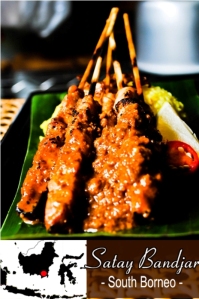
SATAY BANDJAR (South Borneo)
Banjdar is the name of a tribe in the southern part of Borneo. They live in a city called Banjarmasin. Satay Bandjar is a very popular variant of chicken satay. The amount of chili that is used in the recipe quite a lot that make this kind of satay is quite hot. The dish is usually served together with rice cake.
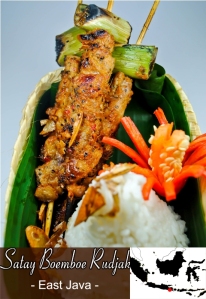
SATAY BOEMBOE RUDJAK (East Java)
Another name is Satay Komoh, it is made from beef with sweet-spicy flavor, whereas the chunk of the beef is usually (or to be precise: must be) big pieces. To marinate the meat, we use shallot, garlic, red hot beauty chili, lime leaves and lemongrass that are blended together with a little bit of tamarind juice. It is such a bustling taste that is compatible with the characteristic of East Java People who speak and laugh loudly! This is a must element during the East Javanese feast. To grill the SATAY, the limb of banana leaves is used in each skewer to balance the heat from the grill.
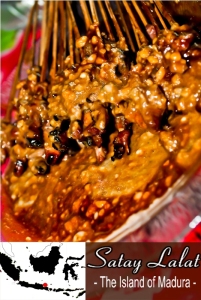
SATAY LALAT (The Island Of Madura)
LALAT/Laler is local dialect to refer flies! What? Yes flies. Worry not, it is just the title of the food. It is actually chuck of lambs that are cut into very small pieces just like flies flash. In one portion consists about 25 satay skewer. You will not getting full having these 25 skewers of super small pieces of lamb that looks like flies.
Originating from the island of Madura, the base of the black sauce is made from sweet soya sauce with palm sugar, garlic, deep fried shallots, peanut paste and shrimp paste. Raw thinly sliced shallot and chilies are the common condiment.

SATAY LILIT (The God Island of Bali)
Balinese cooking is famous with its strong taste due to the use of some strong ingredients such as galangal, lime leaves, ginger, lemon grass. A satay variant with strong taste from Bali named Satay Lilit. It is made from mince fish that is mixed with the strong spices above together with grated coconut then wounded (lilit) around bamboo stick or lemongrass stick. This Satay is served plain, to emphasize the taste of the exotic spiced meat bursting in mouth.

SATAY KARI VEGETARIAN
After exploring various taste of satay from several regions in Indonesia, it is time for me to go back to my kitchen. My mission of the day is to re-interpret satay that I enjoyed from around Indonesia. I combine some elements: the basic ingredients, the marinade seasoning, sauce seasoning and its condiment.
I chose vegetarian as the basic ingredients that also delicious to be grilled. I pick mushrooms, broccoli, eggplant and onions. I will bring together the marinade and sauce seasoning so it is simple and easy (also serve plain like Satay Lilit). The Kari choice is inspired from Satay Padang, but I remove the rice flour. I blend together shallot, garlic, cinnamon, cloves, ginger, lemongrass, cumin and very small amount of tamarind (just like in Satay Boemboe Rudjak). I stir fried the blended spices and marinade the veggie inside, put in the refrigerator. Leave it for one hour before they go to the grill.
Yes, it tastes similar to Indian food, but goes well with these grilled veggies. As my condiment made pickles from cucumbers, carrots, shallots (yes right, like slice of shallots in Satay Lalat) and red hot beauty chilies, to perform a combination of spicy-sweet-sour.

